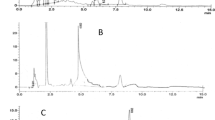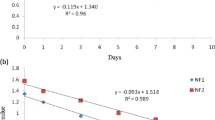Abstract
Tomato, Lycopersicon esculentum L. is grown widely as an important day-to-day demand vegetable. The crop is attacked by various polyphagous insect pests like tomato fruit borer, stink bug, cabbage looper, flea beetle, aphids, whitefly, two-spotted spider mite, etc., and oligophagous insects like leaf-miner, five-spotted hawkmoth, etc. To combat the damage and yield loss, various chemical insecticides were sprayed on tomatoes under field conditions. The residual pattern of insecticides like chlorantraniliprole, thiamethoxam, flubendiamide, and deltamethrin residues was studied following applications of chlorantraniliprole 18.5% SC (Coragen) @ 30 g a.i./ha, thiamethoxam 25% WG (Actara) @ 50 g a.i./ha, flubendiamide 39.35 M/M SC (Fame) @ 48 g a.i./ha and deltamethrin 2.8% EC (Decis 100) @ 12.5 g a.i./ha using Reverse Phase High-Performance Liquid Chromatography (RP-HPLC). Fruit samples were collected at 0 (1 h after application), 1, 2, 3, 5, 7 days and at harvest time. All the residues of insecticides such as chlorantraniliprole (0.09 mg kg− 1), thiamethoxam (0.03 mg kg− 1), flubendiamide (0.02 mg kg− 1), and deltamethrin (0.01 mg kg− 1) were persisted up to 5th day. There were no residues found at harvest time. The residues of chlorantraniliprole and deltamethrin persisted up to 3rd day of spraying whereas the residues of flubendiamide and thiamethoxam were not detected on the same day in the soil.
Similar content being viewed by others
References
Akoijam R, Ningombam A, Beemrote A, Telem RS (2018) RP-HPLC method for determination of organophosphate and synthetic pyrethroids insecticides. Int J Curr Microbiol Appl Sci 7(11):3036–3041
Akoijam R, Ningombam A, Beemrote A, Telem RS (2019) Modified QuEChERS methodology for cole crops. Indian J Entomol 81(1):44–47
Akoijam R, Seni A, Patra S Organic pest management strategies in tomato. In: Eco-friendly pest management strategies for major vegetable crops., Saha T (2020) Managanvi K and Chandran N. Published by Dr. Updesh Purohit for Agrobios (India), Jodhpur. Pp. 29–45
Anastassiades M, Lehotay SJ, Stajnbaher D, Schenck FJ (2003) Fast and easy multiresidue method employing acetonitrile extraction/partitioning and dispersive solid-phase extraction for the determination of pesticide residues in produce. J AOAC International 86:412–443
Bentley KS, Fletcher JL, Woodward MD (2010) Chlorantraniliprole: An Insecticide of the Anthranilic Diamide Class. Hayes’ Handbook of Pesticide Toxicology (Third Edition). Pp. 2231–2242
Doi H, Kikuchi H, Murai H, Kawano Y, Shigeto H, Ohyagi Y, Kira J (2006) Motor neuron disorder simulating ALS induced by chronic inhalation of pyrethroid insecticides. Neurology 67(10):1894–1895. https://doi.org/10.1212/01.wnl.0000244489.65670.9fPMID 17130437
Hafez RO, Singh B (2016) Persistence of thiamethoxam in/on tomato fruits and soil. J Insect Sci 29(1):25–31
Hoskins WM (1961) Mathematical treatment of loss of pesticide residues. FAO Plant Prot Bull 9:163–168
Kadala A, Charreton M, Collet C (2020) Flubendiamide, the first phthalic acid diamide insecticide, impairs neuronal calcium signalling in the honey bee’s antennae. J Insect Physiol 125:104086
Kooner R, Sahoo SK, Singh B, Battu RS (2010) Dissipation kinetics of flubendiamide and thiacloprid on tomato (Lycopersicon esculentum Mill) and soil. Qual Assur Saf Crops Foods 2(1):36–40
Malhat F, Abdallah H, Hegazy I (2012) Dissipation of chlorantraniliprole in tomato fruits and soil. Bull Environ Contam Toxicol 88:349–351. https://doi.org/10.1007/s00128-011-0465-y
Mukherjee I, Kumar A, Kumar A (2015) Dissipation of deltamethrin, triazophos, and endosulfan in ready mix formulations in tomato (Lycopersicon esculentum L.) and eggplant (Solanum melongena L). Environ Sci Pollut Res 22:14169–14177. https://doi.org/10.1007/s11356-015-4637-x
Paramasivam M, Banerjee H (2012) Persistence and dissipation of the Insecticide Flubendiamide and its Metabolite Desiodo Flubendiamide residues in Tomato Fruit and Soil. Bull Environ Contam Toxicol 88:344–348
Roger C (1997) Validation of chromatographic methods in biomedical analysis viewpoint and discussion. J Chrom B 689:175–180
Schneider CW, Tautz J, Grunewald B, Fuchs S (2012) RFID tracking of sublethal effects of two Neonicotinoid Insecticides on the Foraging Behavior of Apis mellifera”. PLOS NE. 7 (1):e30023 Bibcode:2012PLoSO… S. https://doi.org/10.1371/journal.pone.0030023. PMC 3256199. PMID 22253863
Zhang Y, Zhang L, Xu P, Li J, Wang H (2015) Dissipation and residue of pymetrozine in rice field ecosystem. Environ Monit Assess 187:781–786. https://doi.org/10.1007/s10661-014-4256-x
Acknowledgements
The authors are thankful to the Director, ICAR Research Complex for NEH Region, Umiam for providing the necessary research facilities.
Funding
There were no sources of funding
Author information
Authors and Affiliations
Corresponding authors
Ethics declarations
Ethics Approval
There were no financial or non-financial interests, no study-specific approval by the appropriate ethics committee for research involving humans and/or animals.
Competing Interests
No potential conflict of interest was reported by the author. The authors declared that they have no known competing financial interests or personal relations that could have appeared to influence the work reported in this paper.
Additional information
Publisher’s Note
Springer Nature remains neutral with regard to jurisdictional claims in published maps and institutional affiliations.
Rights and permissions
Springer Nature or its licensor (e.g. a society or other partner) holds exclusive rights to this article under a publishing agreement with the author(s) or other rightsholder(s); author self-archiving of the accepted manuscript version of this article is solely governed by the terms of such publishing agreement and applicable law.
About this article
Cite this article
Akoijam, R., Ningombam, A., Beemrote, A. et al. Residual Pattern of Chlorantraniliprole, Thiamethoxam, Flubendiamide and Deltamethrin in Tomato Fruit and Soil. Bull Environ Contam Toxicol 111, 69 (2023). https://doi.org/10.1007/s00128-023-03799-1
Received:
Accepted:
Published:
DOI: https://doi.org/10.1007/s00128-023-03799-1




